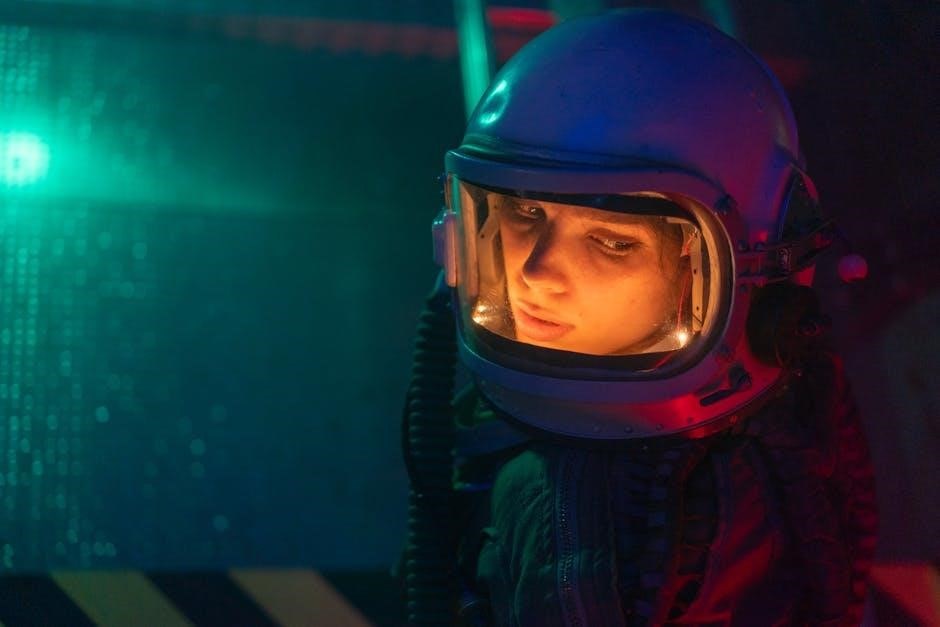Star Trek: Voyager premiered in 1995, introducing the USS Voyager, a starship stranded 70,000 light-years from Earth. The series blends science fiction, adventure, and character-driven storytelling, exploring the Delta Quadrant while emphasizing survival and diplomacy. It became a cornerstone of the Star Trek franchise, known for its unique premise and strong ensemble cast.
1.1 Overview of the Series
Star Trek: Voyager is a groundbreaking series that aired from 1995 to 2001, spanning seven seasons and 172 episodes. It follows the USS Voyager, a Federation starship stranded 70,000 light-years from Earth in the uncharted Delta Quadrant. The crew, led by Captain Kathryn Janeway, must navigate alien worlds, forge alliances, and confront enemies while seeking a way home. The series uniquely blends science fiction, adventure, and diplomacy, offering a fresh perspective on exploration and survival. It became a cornerstone of the Star Trek franchise, celebrated for its compelling storytelling and character development.
1.2 The USS Voyager and Its Crew
The USS Voyager, an Intrepid-class starship, is designed for deep space exploration, equipped with advanced technology like warp drive and bio-neural gel packs. Under Captain Kathryn Janeway’s command, the crew includes a diverse mix of Starfleet and Maquis personnel. Key crew members like Commander Chakotay, Lieutenant Tuvok, and B’Elanna Torres bring unique skills and perspectives. The ship’s mission to survive in the Delta Quadrant relies on ingenuity, teamwork, and adaptability, making the crew’s dynamic and chemistry central to the series’ narrative and appeal.
Season One
Season One introduces the USS Voyager’s journey, starting with the pilot episode “Caretaker,” which sets the series’ premise. Key episodes like “Parallax” and “The Phage” highlight the crew’s early struggles and adaptation to life in the Delta Quadrant, showcasing character development and the series’ potential.
2.1 “Caretaker” ― The Pilot Episode
The pilot episode “Caretaker” introduces the USS Voyager, led by Captain Kathryn Janeway, as it ventures into the Badlands to pursue a Maquis ship. A powerful alien probe transports both vessels to the Delta Quadrant, 70,000 light-years from Earth. Stranded and forced to merge crews, Voyager’s mission shifts from pursuit to survival. This episode sets the series’ premise, showcasing the challenges of exploration and the crew’s resilience. It establishes the core themes of unity, adaptation, and the quest to return home, laying the foundation for the series’ epic journey.
2.2 Key Episodes: “Parallax” and “The Phage”
“Parallax” delves into the crew’s struggle with their new reality, as they confront the challenges of being stranded. A temporal anomaly creates a parallel timeline, highlighting the tension between Janeway and her first officer, Chakotay. Meanwhile, “The Phage” introduces the Vidiians, a species harvesting organs to survive. Both episodes explore themes of identity and survival, showcasing the crew’s growing unity and resourcefulness. These early installments set the tone for the series, blending character development with high-stakes scenarios that define Voyager’s journey in the Delta Quadrant.

Season Two
Season Two deepens the crew’s struggles in the Delta Quadrant, exploring themes of survival, unity, and the unknown. Episodes like “Initiations” and “Elogium” highlight the challenges faced by the crew as they adapt to their new reality, balancing exploration with the constant threat of danger. The season emphasizes character growth and the evolving dynamics between the Federation and Maquis crew members, setting the stage for future conflicts and discoveries.
3.1 “Initiations” and “Elogium”
In “Initiations,” Chakotay faces a rite of passage with a young Kazon warrior, exploring themes of identity and survival. “Elogium” delves into B’Elanna’s struggle with her Klingon heritage as she confronts a biological imperative. Both episodes highlight the crew’s personal growth and the moral dilemmas they encounter in the Delta Quadrant, showcasing the series’ ability to blend character-driven stories with broader philosophical questions. These episodes exemplify the season’s focus on unity and resilience amidst the unknown.
3.2 “Non Sequitur” and “Twisted”
“Non Sequitur” explores Harry Kim’s alternate reality, where he never joined Voyager, challenging his sense of identity. In “Twisted,” an alien entity manipulates the ship’s reality, creating chaotic scenarios. Both episodes showcase the crew’s resilience and ability to adapt to unpredictable situations, blending suspense with character insight. These stories highlight the series’ knack for blending psychological drama with sci-fi elements, offering unique perspectives on the crew’s dynamics and personal struggles in the Delta Quadrant.

Season Three
Season Three of Star Trek: Voyager features episodes like “Basics, Part II” and “Flashback,” showcasing the crew’s resilience and resourcefulness. The season delves into tense confrontations and unique alien encounters, deepening the series’ exploration of survival and unity in the Delta Quadrant.
4.1 “Basics, Part II” and “Flashback”
“Basics, Part II” concludes the intense two-part saga, with Voyager’s crew fighting to reclaim their ship from the Kazon. The episode escalates tensions as Seska’s betrayal reaches its peak, and the crew must use all their resources to survive. “Flashback” offers a unique narrative, as Tuvok’s memories of serving under Captain Sulu in Star Trek VI: The Undiscovered Country are intertwined with the present. This episode blends nostalgia with character development, showcasing the depth of Tuvok’s past and its impact on his current role aboard Voyager.
4.2 “The Swarm” and “False Profits”
“The Swarm” delves into Voyager’s perilous journey through a nebula inhabited by aggressive, insectoid creatures. The crew must navigate this treacherous region while protecting the ship from the swarm’s relentless attacks, adding tension to their survival mission. “False Profits” introduces the Ferengi, who have established a lucrative trade monopoly on a Delta Quadrant planet. This episode blends humor with moral dilemmas, as the crew confronts the Ferengi’s greed and exploitation, offering a unique blend of comedy and social commentary within the series’ overarching narrative.

Season Four
Season Four explores intense conflicts, including encounters with the Borg and Species 8472 in “Scorpion” and “The Gift.” The crew faces moral dilemmas in “Year of Hell” and “The Killing Game,” showcasing their resilience and ingenuity in the Delta Quadrant.
5.1 “Scorpion” and “The Gift”
The two-part episode “Scorpion” marks a pivotal moment as Voyager forms an uneasy alliance with the Borg to combat Species 8472, a powerful alien threat. In “The Gift,” Kes’s abilities evolve, leading to significant changes for the crew. These episodes showcase the crew’s resourcefulness and the moral complexities of survival in the Delta Quadrant, while deepening character dynamics and setting the stage for future challenges.
5.2 “Year of Hell” and “The Killing Game”
“Year of Hell” thrusts Voyager into a prolonged battle with the Krenim, altering the timeline and testing the crew’s resilience. In “The Killing Game,” the crew is captured by the Hirogen, who force them to participate in brutal holodeck simulations. These episodes highlight the crew’s endurance and ingenuity while exploring themes of time manipulation and the ethics of reality distortion, delivering intense drama and character growth.
Season Five
Season Five explores diverse themes, from moral dilemmas in Latent Image to the humorous Bride of Chaotica!. Episodes like Gravity and Course: Oblivion delve into emotional struggles and dramatic twists.
6.1 “Latent Image” and “Bride of Chaotica!”
“Latent Image” delves into the moral complexities of holographic rights, as the Doctor discovers suppressed memories. In “Bride of Chaotica!”, a comedic tale unfolds when aliens misinterpret Tom Paris’s holodeck program, believing it to be real; These episodes showcase the series’ ability to balance serious ethical questions with lighthearted humor, offering diverse storytelling within the same season.
6.2 “Gravity” and “Course: Oblivion”
In “Gravity,” the crew faces a gravitational anomaly that threatens to pull the ship into a planet’s surface. Tuvok, Paris, and the Doctor work together to devise a solution, showcasing their ingenuity and teamwork. Meanwhile, “Course: Oblivion” follows a duplicate Voyager crew created by a alien race, whose ship begins to deteriorate. This episode explores themes of identity and mortality, adding emotional depth to the season’s narrative. Both episodes highlight the series’ ability to blend scientific challenges with character-driven stories.
Notable Themes and Storylines
Star Trek: Voyager explores themes of survival, diplomacy, and exploration, delving into the challenges of navigating the unknown Delta Quadrant. The series emphasizes character growth, ethical dilemmas, and the crew’s resilience, blending action with emotional depth to create a compelling narrative. These elements define the show’s unique identity and appeal.
7.1 The Delta Quadrant and Its Mysteries
The Delta Quadrant, a vast and uncharted region of space, serves as the backdrop for Star Trek: Voyager’s epic journey. Filled with mysterious phenomena, alien species, and unexplored worlds, the quadrant presents endless challenges and discoveries. From encounters with the enigmatic Borg to the dangerous Vidiians, the crew faces unparalleled threats. Episodes like “The Swarm” and “False Profits” highlight the quadrant’s unpredictability, while its diverse cultures and civilizations add depth to the series’ exploration of the unknown. The Delta Quadrant’s mysteries drive the narrative, making it a central element of the show’s identity and appeal.
7.2 Character Development and Relationships
Star Trek: Voyager excels in portraying the growth and dynamics of its crew. Captain Janeway’s leadership evolves from strict adherence to protocol to empathetic decision-making. Chakotay’s spiritual depth and Seven of Nine’s journey from Borg drone to individual highlight the series’ focus on personal transformation. The Doctor’s holographic character gains emotional depth, while Tom Paris and B’Elanna Torres’s relationship adds a personal layer. These developments, alongside the crew’s unity in adversity, create a compelling narrative that explores humanity, loyalty, and resilience, making the characters relatable and endearing to audiences.

Fan Reception and Legacy
Star Trek: Voyager has a dedicated fan base, praised for its storytelling and character development. Its legacy endures as a beloved chapter in the Star Trek franchise, celebrated for its unique premise and memorable episodes that continue to resonate with audiences.
8.1 Impact on Star Trek Franchise
Star Trek: Voyager left an indelible mark on the franchise by introducing the first female captain, Kathryn Janeway, and exploring the uncharted Delta Quadrant. Its seven-season run showcased innovative storytelling, blending standalone episodes with serialized arcs. The series expanded the franchise’s creative horizons, paving the way for future series like Star Trek: Picard and Lower Decks. Its legacy lies in its ability to balance character-driven narratives with the franchise’s signature exploration of the unknown, cementing its place as a pivotal chapter in the Star Trek saga.
8.2 Fan-Favorite Episodes
Fans of Star Trek: Voyager often highlight episodes like “Latent Image” and “Bride of Chaotica!” for their unique storytelling. “Latent Image”, rated 8.3, explores themes of identity and ethics, while “Bride of Chaotica!”, rated 7.3, offers a lighthearted adventure. Other fan favorites include “Year of Hell” and “The Killing Game”, praised for their intense, serialized narratives. These episodes showcase the series’ ability to balance drama, humor, and action, resonating deeply with audiences and solidifying their place in fan culture.
Star Trek: Voyager leaves a lasting legacy, celebrated for its compelling storytelling and loyal fan base, marking its enduring impact on the Star Trek franchise and culture.
9;1 Final Thoughts on the Series
Star Trek: Voyager stands as a testament to resilience and exploration, blending science fiction with deep character development. The crew’s journey through the Delta Quadrant, spanning 79 episodes, captivated audiences with its unique premise and emotional depth. The series legacy endures, celebrated for its strong ensemble cast and thought-provoking themes. As a fan favorite, it remains a pivotal chapter in the Star Trek franchise, inspiring countless viewers and solidifying its place in television history.
9.2 The Episode Guide as a Resource
The Episode Guide for Star Trek: Voyager is an invaluable resource for fans, detailing all 79 episodes aired from 1995 to 2001. It provides titles, synopses, and air dates, making it easy to navigate the series. This guide highlights key episodes like “Caretaker,” “Year of Hell,” and “Latent Image,” offering insights into the show’s narrative arcs and character development. For both casual viewers and dedicated fans, the episode guide serves as a comprehensive companion, enhancing the appreciation of Voyager’s journey through the Delta Quadrant.

